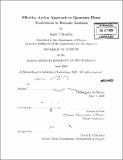Effective action approach to quantum phase transitions in bosonic lattices
Author(s)
Bradlyn, Barry J
DownloadFull printable version (1.938Mb)
Other Contributors
Massachusetts Institute of Technology. Dept. of Physics.
Advisor
Roman Jackiw.
Terms of use
Metadata
Show full item recordAbstract
In this thesis, I develop a new, field-theoretic method for describing the quantum phase transition between Mott insulating and superfluid states observed in bosonic optical lattices. I begin by adding to the Hamiltonian of interest a symmetry breaking source term. Using time-dependent perturbation theory, I then expand the grand-canonical free energy as a double power series in both the tunneling and the source term. From here, an order parameter field is introduced, and the underlying effective action is derived via a Legendre transformation. After determining the Ginzburg-Landau expansion of the effective action to first order in the tunneling term. expressions for the Mott insulator-superfluid phase boundary, condensate density, average particle number, and compressibility are derived and analyzed in detail. Additionally, excitation spectra in the ordered phase are found by considering both longitudinal and transverse variations of the order parameter. Finally, these results are applied to the concrete case of the Bose-Hubbard Hamiltonian on a three dimensional cubic lattice, and compared with the corresponding results from mean-field theory. Although both approaches yield the same Mott insulator - superfluid phase boundary to first order in the tunneling, the predictions of the effective action theory turn out to be superior to the mean-field results deeper into the superfluid phase.
Description
Thesis (S.B.)--Massachusetts Institute of Technology, Dept. of Physics, 2009. Includes bibliographical references (p. 51-54).
Date issued
2009Department
Massachusetts Institute of Technology. Department of PhysicsPublisher
Massachusetts Institute of Technology
Keywords
Physics.